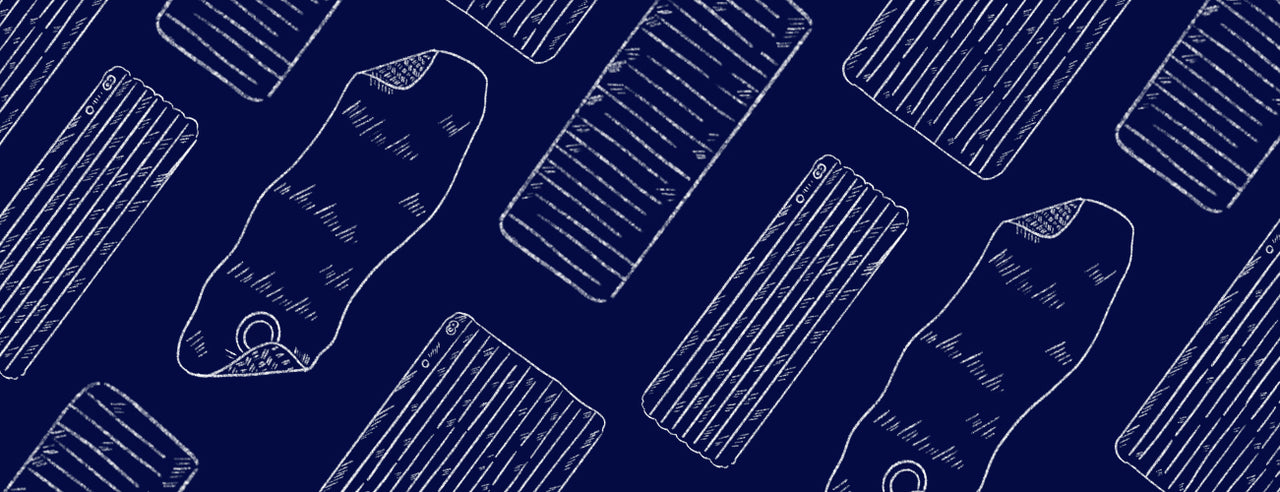Sleep in slightly above the dirt.
Get comfy out there with these tips:
Protecting Your Sleeping Pad
Your pad is covered by our warranty against manufacturing and material defect. Your pad is not covered against punctures made by exposing it to the elements. Cowboy camping is phenomenal, but best practice is to put some protection (like a footprint) under your pad first. Your pad is intended for many warm, comfortable siestas. Your pad is not intended for glissading, Jet-Boiling, or rafting.
Setting Up Your Big Agnes System Bag & Pad
Our system bags unite a sleeping bag and pad into one. Setting it up is pretty painless: Simply slide your logo side up pad into the sleeve underneath your sleeping bag. Inflate the pad before you put it in the bag or after. If you are using one of our thicker sleeping pads, it may be easier to partially inflate the pad, slide it in the sleeve and then finish inflating when it is securely in place.
Keep in mind that Big Agnes System sleeping bags are designed without insulation between the bag and your sleeping pad. Insulation doesn't do its job when it's compressed, so this design adds comfort by keeping you from laying on clumped insulation, and reduces extra weight and bulk. However, to keep you warm at night you'll want to make sure you have an appropriately insulated sleeping pad to pair with your sleeping bag.
Managing Your Pad's Inflation Level
After you first inflate your sleeping pad with your breath, the air inside will be quite warm. When the air in your pad cools down as outside temperatures drop, so will the air inside your pad. As this happens, you may notice that your pad seems less inflated than it was originally - don't worry, your pad isn't leaking!
As the air in your pad gets colder, its volume decreases, which may make your pad less firm than you'd like. Not to worry, just add a few more breaths of air and you're good to go!
This works the opposite way too - if you're leaving your pad inflated at camp on a hot day while you're out adventuring, the heat of the day may cause the air inside to expand. In extreme cases, this expansion can lead to your pad bursting at the seams and leaking! When leaving your pad inflated on a hot day, we recommend letting some air out first to allow for this expansion.
Using a Pumphouse Pad Inflation Sack
The Pumphouse and other pad inflation sacks drastically reduce sleeping pad inflation time by gathering a large amount of air at one time and easily pushing it through the sleeping pad inflation valve. This not only saves your lungs from extra work after a long day, but also keeps moisture from your breath from getting inside your pad and potentially creating mold.
It doubles as a stuff sack, pad pump, dry sack, pillow, backcountry shower and more. Can also be used with standard sized traditional valves. All Big Agnes air chamber sleeping pads come with a pad inflation sack.
Instructions for use:
- Open valve end and place on opened sleeping pad in-valve. Open stuff sack end and allow air to enter, then roll stuff sack end continuously to inflate pad with the air trapped inside the Pumphouse Ultra. Repeat until pad has reached desired inflation.
Deflating And Packing Your Pad
Your pad comes from the factory tightly rolled and in its own stuff sack, and that's the best way to pack and store it all the time! However, that can be easier said than done sometimes. To effectively pack your pad:
Lay It Out
Lay your pad somewhere flat, and let air out by either opening the OUT valve (2-valve pads), inserting the keyed tab on the plug into the valve (1-valve pads and pillows), or completely removing the plug (Self-inflating pads). Adding body weight or other pressure can make this process go faster.
Pro Tip: If you happen to be near a picnic table, these make for great pad deflation staging grounds to save your back and keep your pad clean.
Fold Your Pad
To fit in its stuff sack, your pad is designed to be folded in thirds (Air Chamber pads), or in half (Self-inflating pads), lengthwise.
Roll, Don't Stuff
After your pad is folded, it's time to roll! Use your body weight to tightly roll your pad, starting from the bottom, up toward the valve. It may be called a stuff sack, but stuffing your pad in there is no easy task, and may cause damage to the sack.
Drop it in
If you're able to achieve a nice, tight roll, you should find that your pad fits in its stuff sack with room to spare! If that's the case, close up your stuff sack and hit the trail! If not, give the deflating and rolling steps another try.


 United States (USD) | EN
United States (USD) | EN 
